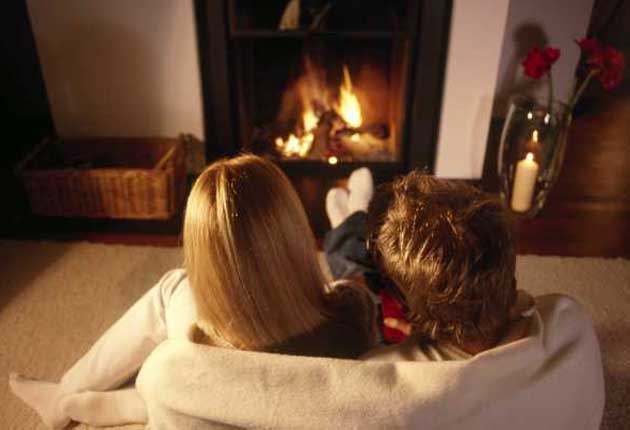Open fires: Gorgeous <i>and</i> good value
Got a romantic notion about having an open fire? Go ahead – it's a great way to save money, says Jimmy Lee Shreeve

As the cold and credit crunch bite, more and more people are turning to open fires to keep themselves warm and cut down on skyrocketing fuel bills. But it isn't only about saving money; there's something satisfying and primal about building your own fire – perhaps because it dates back to the dawn of our species. Looking into the flames also has a strong aesthetic, almost hypnotic, appeal.
"I always like to have an open fire wherever I hang up my hat," says London-based actor Robert Goodman, whose movie credits include Gangs of New York. "But for me, saving money is always a secondary consideration, even in austere times when I need to cut back. You simply can't beat staring into the flames on a cold winter's night – it stimulates your imagination and is often more rewarding than watching television."
As well as their romantic appeal, open fires can also save you money. Recent figures from the Solid Fuel Technology Institute (www.soliftec.com) suggest that burning wood alone, or mixed with coal, costs around half that of gas or oil – and that's leaving aside free supplies collected from skips or the countryside.
Unsurprisingly, sales of wood-burning and multi-fuel stoves are up 40 per cent on last year, according to the Solid Fuel Association (www.solidfuel.co.uk). The president of the Coal Merchants Federation reported a 20 per cent increase in sales, with fellow members enjoying similar rises in business. And the National Association of Chimney Sweeps noted a "resurgence" in demand for their services – to the point that some firms now have two- or three-month waiting lists.
Most older properties will have a fireplace, but often it will be blocked off with plasterboard or bricks. Fortunately, these can be removed fairly easily. But before you light a fire, it's important to check that the chimney is clear and hasn't been capped. It might also be necessary to hire a builder to fix any deteriorated mortar pointing in the chimney.
Another thing to find out is whether you live in a smoke-control area – a common regulation in most large towns and cities in the UK. You can check this at www.uksmokecontrolareas.co.uk. If you live in a smokeless zone, you'll have to use smokeless fuel (anthracite, for example), not wood or standard coal.
Your chimney also needs to be swept on a regular basis, which costs around £30 to £40. Gas and smokeless-fuel fires should be cleaned once a year, coal twice and wood four times a year. It's a skilled job, so only use chimney sweeps that are registered with the National Association of Chimney Sweeps (www.nacs.org.uk). Its members have to go through rigorous checks and tests before they can join.
One of the key aims of the association is to focus people's attention on heating their homes safely. "The two things we're trying to do are to eliminate the horrors and dangers of chimney fires, and to prevent the tragedies of carbon monoxide poisoning caused by blocked chimneys and flue-ways," says the association's president, Martin Glynn, who also runs BG Wright Master Sweep Services (www.chimneysweep.co.uk).
Glynn says a chimney fire typically starts when people burn green wood, which still has oil and sap in it. "This mixes with water vapour and other volatiles, goes up into a cold chimney, cools down and can roll back into the chimney where it condenses as tar." Left untreated this can become highly flammable. According to research conducted for the Carbon Monoxide – Be Alarmed! campaign (www.co-bealarmed.co.uk), more than half of UK households have a chimney, but few are aware that not getting it swept regularly can lead to carbon monoxide poisoning, which can be fatal (around 30 deaths occur each year).
"Blockages in the chimney can alter the combustion balance or cause carbon monoxide to enter the home, instead of being safely vented from the property outside," says Bob Russell from the Guild of Master Sweeps (www.guild-of-master-sweeps.co.uk). "Even if you only use your fire at Christmas, you still need to get your chimney swept at least annually to protect yourself from the risk of carbon monoxide poisoning."
If your aim is to save money, there's another issue with open fires – as much as 90 per cent of the heat goes up the chimney. The most efficient alternative is to install a multi-fuel or wood-burning boiler/stove, which can be combined with your existing oil or gas central-heating system, or it can replace it altogether.
If you're worried about green issues, then a wood-burning stove or log fire is the way to go. Wood is considered carbon neutral because it only releases the CO2 captured by the growth of the tree. And an efficient multi-fuel fire (half wood and half smokeless fuel) produces less carbon dioxide than a gas condensing boiler. Then there are green fuels, such as Green Dragon briquettes (www.greendragonfuel.co.uk), which are made as a by-product of oil-seed rape and provide both eco-benefits and cost savings – they burn three times as long as wood and give off twice as much heat.
The ultimate in saving is to forage for wood yourself. But as actor Robert Goodman says: "You do need to be able to tell your ash from your oak." Hard woods such as ash burn far more slowly than soft woods such as cedar. And he offers another good tip: "It needs to be seasoned," he says. "Keep it off the ground and well-ventilated for a good nine months, and it'll burn a treat."
Subscribe to Independent Premium to bookmark this article
Want to bookmark your favourite articles and stories to read or reference later? Start your Independent Premium subscription today.

Join our commenting forum
Join thought-provoking conversations, follow other Independent readers and see their replies